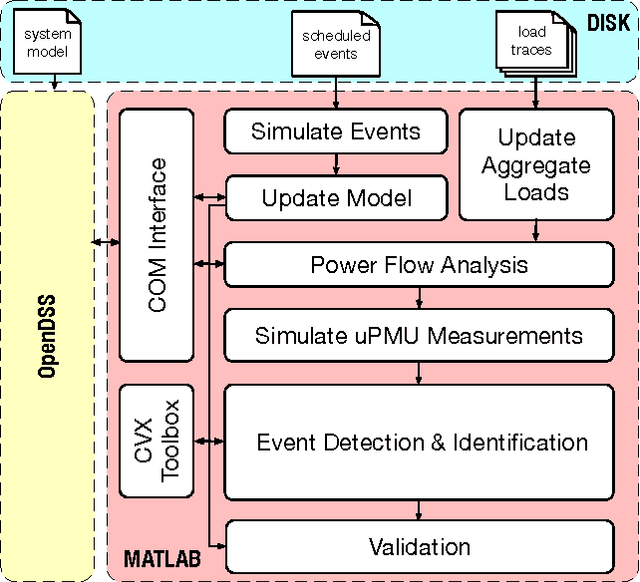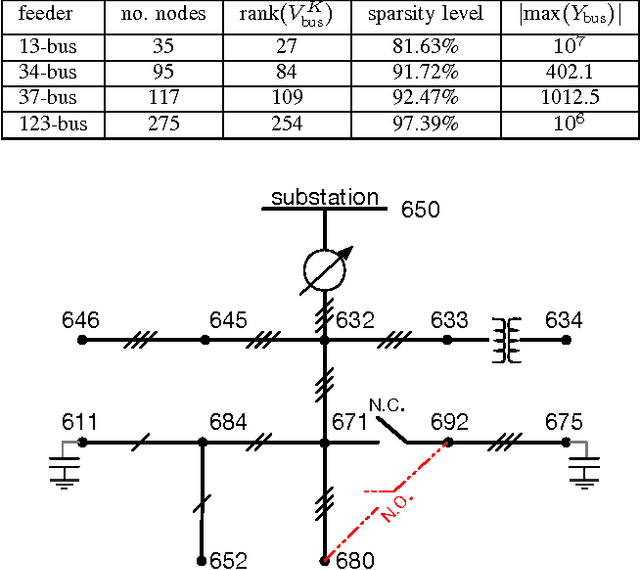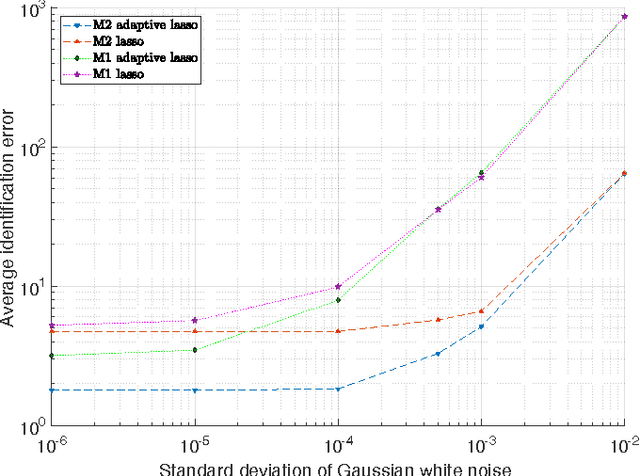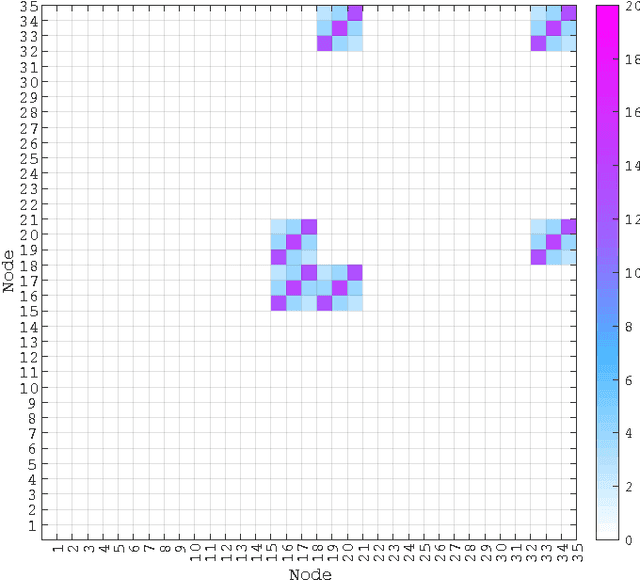Vincent W. S. Wong
Distributed Precoding for Cell-free Massive MIMO in O-RAN: A Multi-agent Deep Reinforcement Learning Framework
Oct 31, 2025Abstract:Cell-free massive multiple-input multiple-output (MIMO) is a key technology for next-generation wireless systems. The integration of cell-free massive MIMO within the open radio access network (O-RAN) architecture addresses the growing need for decentralized, scalable, and high-capacity networks that can support different use cases. Precoding is a crucial step in the operation of cell-free massive MIMO, where O-RUs steer their beams towards the intended users while mitigating interference to other users. Current precoding schemes for cell-free massive MIMO are either fully centralized or fully distributed. Centralized schemes are not scalable, whereas distributed schemes may lead to a high inter-O-RU interference. In this paper, we propose a distributed and scalable precoding framework for cell-free massive MIMO that uses limited information exchange among precoding agents to mitigate interference. We formulate an optimization problem for precoding that maximizes the aggregate throughput while guaranteeing the minimum data rate requirements of users. The formulated problem is nonconvex. We propose a multi-timescale framework that combines multi-agent deep reinforcement learning (DRL) with expert insights from an iterative algorithm to determine the precoding matrices efficiently. We conduct simulations and compare the proposed framework with the centralized precoding and distributed precoding methods for different numbers of O-RUs, users, and transmit antennas. The results show that the proposed framework achieves a higher aggregate throughput than the distributed regularized zero-forcing (D-RZF) scheme and the weighted minimum mean square error (WMMSE) algorithm. When compared with the centralized regularized zero-forcing (C-RZF) scheme, the proposed framework achieves similar aggregate throughput performance but with a lower signaling overhead.
Generalized Pinching-Antenna Systems: A Tutorial on Principles, Design Strategies, and Future Directions
Oct 15, 2025Abstract:Pinching-antenna systems have emerged as a novel and transformative flexible-antenna architecture for next-generation wireless networks. They offer unprecedented flexibility and spatial reconfigurability by enabling dynamic positioning and activation of radiating elements along a signal-guiding medium (e.g., dielectric waveguides), which is not possible with conventional fixed antenna systems. In this paper, we introduce the concept of generalized pinching antenna systems, which retain the core principle of creating localized radiation points on demand, but can be physically realized in a variety of settings. These include implementations based on dielectric waveguides, leaky coaxial cables, surface-wave guiding structures, and other types of media, employing different feeding methods and activation mechanisms (e.g., mechanical, electronic, or hybrid). Despite differences in their physical realizations, they all share the same inherent ability to form, reposition, or deactivate radiation sites as needed, enabling user-centric and dynamic coverage. We first describe the underlying physical mechanisms of representative generalized pinching-antenna realizations and their associated wireless channel models, highlighting their unique propagation and reconfigurability characteristics compared with conventional antennas. Then, we review several representative pinching-antenna system architectures, ranging from single- to multiple-waveguide configurations, and discuss advanced design strategies tailored to these flexible deployments. Furthermore, we examine their integration with emerging wireless technologies to enable synergistic, user-centric solutions. Finally, we identify key open research challenges and outline future directions, charting a pathway toward the practical deployment of generalized pinching antennas in next-generation wireless networks.
Generalized User-Oriented Image Semantic Coding Empowered by Large Vision-Language Model
Sep 10, 2025Abstract:Semantic communication has shown outstanding performance in preserving the overall source information in wireless transmission. For semantically rich content such as images, human users are often interested in specific regions depending on their intent. Moreover, recent semantic coding models are mostly trained on specific datasets. However, real-world applications may involve images out of the distribution of training dataset, which makes generalization a crucial but largely unexplored problem. To incorporate user's intent into semantic coding, in this paper, we propose a generalized user-oriented image semantic coding (UO-ISC) framework, where the user provides a text query indicating its intent. The transmitter extracts features from the source image which are relevant to the user's query. The receiver reconstructs an image based on those features. To enhance the generalization ability, we integrate contrastive language image pre-training (CLIP) model, which is a pretrained large vision-language model (VLM), into our proposed UO-ISC framework. To evaluate the relevance between the reconstructed image and the user's query, we introduce the user-intent relevance loss, which is computed by using a pretrained large VLM, large language-and-vision assistant (LLaVA) model. When performing zero-shot inference on unseen objects, simulation results show that the proposed UO-ISC framework outperforms the state-of-the-art query-aware image semantic coding in terms of the answer match rate.
QoS-Aware NOMA Design for Downlink Pinching-Antenna Systems
Apr 18, 2025Abstract:Pinching antennas, implemented by applying small dielectric particles on a waveguide, have emerged as a promising flexible-antenna technology ideal for next-generation wireless communications systems. Unlike conventional flexible-antenna systems, pinching antennas offer the advantage of creating line-of-sight links by enabling antennas to be activated on the waveguide at a location close to the user. This paper investigates a typical two-user non-orthogonal multiple access (NOMA) downlink scenario, where multiple pinching antennas are activated on a single dielectric waveguide to assist NOMA transmission. We formulate the problem of maximizing the data rate of one user subject to the quality-of-service requirement of the other user by jointly optimizing the antenna locations and power allocation coefficients. The formulated problem is nonconvex and difficult to solve due to the impact of antenna locations on large-scale path loss and two types of phase shifts, namely in-waveguide phase shifts and free space propagation phase shifts. To this end, we propose an iterative algorithm based on block coordinate descent and successive convex approximation techniques. Moreover, we consider the special case with a single pinching antenna, which is a simplified version of the multi-antenna case. Although the formulated problem is still nonconvex, by using the inherent features of the formulated problem, we derive the global optimal solution in closed-form, which offers important insights on the performance of pinching-antenna systems. Simulation results demonstrate that the pinching-antenna system significantly outperforms conventional fixed-position antenna systems, and the proposed algorithm achieves performance comparable to the computationally intensive exhaustive search based approach.
Leveraging MoE-based Large Language Model for Zero-Shot Multi-Task Semantic Communication
Mar 21, 2025Abstract:Multi-task semantic communication (SC) can reduce the computational resources in wireless systems since retraining is not required when switching between tasks. However, existing approaches typically rely on task-specific embeddings to identify the intended task, necessitating retraining the entire model when given a new task. Consequently, this drives the need for a multi-task SC system that can handle new tasks without additional training, known as zero-shot learning. Inspired by the superior zero-shot capabilities of large language models (LLMs), we leverage pre-trained instruction-tuned LLMs, referred to as fine-tuned language net (FLAN), to improve the generalization capability. We incorporate a mixture-of-experts (MoE) architecture in the FLAN model and propose MoE-FLAN-SC architecture for multi-task SC systems. Our proposed MoE-FLAN-SC architecture can further improve the performance of FLAN-T5 model without increasing the computational cost. Moreover, we design a multi-task feature extraction module (FEM) which can adaptively extract relevant features across various tasks given the provided features and signal-to-noise ratio (SNR). Simulation results show that our proposed MoE-FLAN-SC architecture outperforms three state-of-the-art models in terms of the average accuracy on four different unseen tasks.
Pinching Antennas: Principles, Applications and Challenges
Jan 18, 2025



Abstract:Flexible-antenna systems, such as fluid antennas and movable antennas, have been recognized as key enabling technologies for sixth-generation (6G) wireless networks, as they can intelligently reconfigure the effective channel gains of the users and hence significantly improve their data transmission capabilities. However, existing flexible-antenna systems have been designed to combat small-scale fading in non-line-of-sight (NLoS) conditions. As a result, they lack the ability to establish line-of-sight links, which are typically 100 times stronger than NLoS links. In addition, existing flexible-antenna systems have limited flexibility, where adding/removing an antenna is not straightforward. This article introduces an innovative flexible-antenna system called pinching antennas, which are realized by applying small dielectric particles to waveguides. We first describe the basics of pinching-antenna systems and their ability to provide strong LoS links by deploying pinching antennas close to the users as well as their capability to scale up/down the antenna system. We then focus on communication scenarios with different numbers of waveguides and pinching antennas, where innovative approaches to implement multiple-input multiple-output and non-orthogonal multiple access are discussed. In addition, promising 6G-related applications of pinching antennas, including integrated sensing and communication and next-generation multiple access, are presented. Finally, important directions for future research, such as waveguide deployment and channel estimation, are highlighted.
Viewport Prediction, Bitrate Selection, and Beamforming Design for THz-Enabled 360-Degree Video Streaming
Jan 23, 2024Abstract:360-degree videos require significant bandwidth to provide an immersive viewing experience. Wireless systems using terahertz (THz) frequency band can meet this high data rate demand. However, self-blockage is a challenge in such systems. To ensure reliable transmission, this paper explores THz-enabled 360-degree video streaming through multiple multi-antenna access points (APs). Guaranteeing users' quality of experience (QoE) requires accurate viewport prediction to determine which video tiles to send, followed by asynchronous bitrate selection for those tiles and beamforming design at the APs. To address users' privacy and data heterogeneity, we propose a content-based viewport prediction framework, wherein users' head movement prediction models are trained using a personalized federated learning algorithm. To address asynchronous decision-making for tile bitrates and dynamic THz link connections, we formulate the optimization of bitrate selection and beamforming as a macro-action decentralized partially observable Markov decision process (MacDec-POMDP) problem. To efficiently tackle this problem for multiple users, we develop two deep reinforcement learning (DRL) algorithms based on multi-agent actor-critic methods and propose a hierarchical learning framework to train the actor and critic networks. Experimental results show that our proposed approach provides a higher QoE when compared with three benchmark algorithms.
Multiple Access Techniques for Intelligent and Multi-Functional 6G: Tutorial, Survey, and Outlook
Jan 02, 2024Abstract:Multiple access (MA) is a crucial part of any wireless system and refers to techniques that make use of the resource dimensions to serve multiple users/devices/machines/services, ideally in the most efficient way. Given the needs of multi-functional wireless networks for integrated communications, sensing, localization, computing, coupled with the surge of machine learning / artificial intelligence (AI) in wireless networks, MA techniques are expected to experience a paradigm shift in 6G and beyond. In this paper, we provide a tutorial, survey and outlook of past, emerging and future MA techniques and pay a particular attention to how wireless network intelligence and multi-functionality will lead to a re-thinking of those techniques. The paper starts with an overview of orthogonal, physical layer multicasting, space domain, power domain, ratesplitting, code domain MAs, and other domains, and highlight the importance of researching universal multiple access to shrink instead of grow the knowledge tree of MA schemes by providing a unified understanding of MA schemes across all resource dimensions. It then jumps into rethinking MA schemes in the era of wireless network intelligence, covering AI for MA such as AI-empowered resource allocation, optimization, channel estimation, receiver designs, user behavior predictions, and MA for AI such as federated learning/edge intelligence and over the air computation. We then discuss MA for network multi-functionality and the interplay between MA and integrated sensing, localization, and communications. We finish with studying MA for emerging intelligent applications before presenting a roadmap toward 6G standardization. We also point out numerous directions that are promising for future research.
Joint User Pairing and Association for Multicell NOMA: A Pointer Network-based Approach
Apr 15, 2020



Abstract:In this paper, we investigate the joint user pairing and association problem for multicell non-orthogonal multiple access (NOMA) systems. We consider a scenario where the user equipments (UEs) are located in a multicell network equipped with multiple base stations. Each base station has multiple orthogonal physical resource blocks (PRBs). Each PRB can be allocated to a pair of UEs using NOMA. Each UE has the additional freedom to be served by any one of the base stations, which further increases the complexity of the joint user pairing and association algorithm design. Leveraging the recent success on using machine learning to solve numerical optimization problems, we formulate the joint user pairing and association problem as a combinatorial optimization problem. The solution is found using an emerging deep learning architecture called Pointer Network (PtrNet), which has a lower computational complexity compared to solutions based on iterative algorithms and has been proven to achieve near-optimal performance. The training phase of the PtrNet is based on deep reinforcement learning (DRL), and does not require the use of the optimal solution of the formulated problem as training labels. Simulation results show that the proposed joint user pairing and association scheme achieves near-optimal performance in terms of the aggregate data rate, and outperforms the random user pairing and association heuristic by up to 30%.
On Identification of Distribution Grids
Nov 05, 2017



Abstract:Large-scale integration of distributed energy resources into residential distribution feeders necessitates careful control of their operation through power flow analysis. While the knowledge of the distribution system model is crucial for this type of analysis, it is often unavailable or outdated. The recent introduction of synchrophasor technology in low-voltage distribution grids has created an unprecedented opportunity to learn this model from high-precision, time-synchronized measurements of voltage and current phasors at various locations. This paper focuses on joint estimation of model parameters (admittance values) and operational structure of a poly-phase distribution network from the available telemetry data via the lasso, a method for regression shrinkage and selection. We propose tractable convex programs capable of tackling the low rank structure of the distribution system and develop an online algorithm for early detection and localization of critical events that induce a change in the admittance matrix. The efficacy of these techniques is corroborated through power flow studies on four three-phase radial distribution systems serving real household demands.
 Add to Chrome
Add to Chrome Add to Firefox
Add to Firefox Add to Edge
Add to Edge